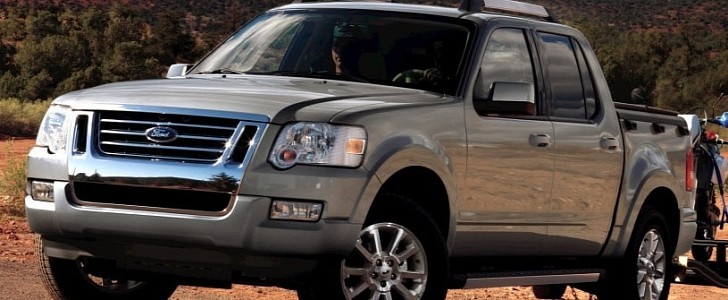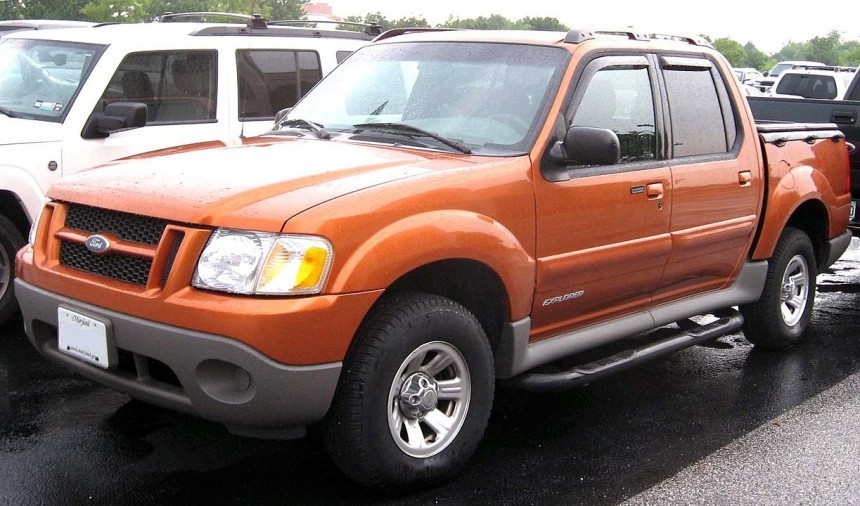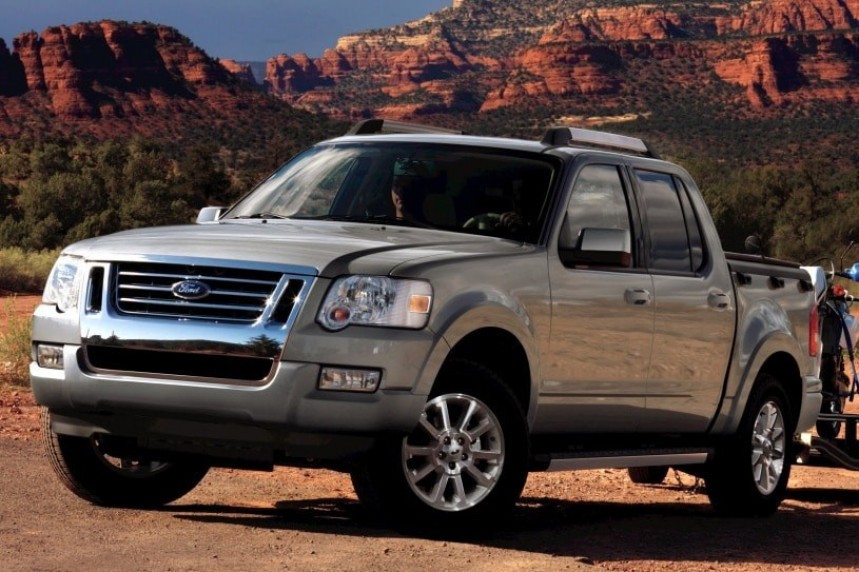If you could, believe it or not, there used to be a time when Americans weren't all that gung-ho about small to mid-size Ford pickup trucks. Or, at least that was the perception Ford had of them.
If you had to point to a singular reason why this sentiment was felt, well, you'd be oversimplifying the endlessly complex and nonsensical buying habits of average yanks. But if you put the proverbial rifle to our heads and told us to pick one light truck that justified a near-decade-long absence from the market, the Ford Explorer Sport Trac would probably be the ticket.
Built over two generations between 2000 and 2010, the Sport Trac took the SUV we all know and love and lopped off a piece to make it into a mid-sized pickup. Think of it being a bit like a Ford Ranger for people that don't want to drive a vehicle as utilitarian and spartan as the Ranger.
It's all too easy to draw parallels between the Explorer Sport Trac and the Ranger. Both are sub-full-size pickup trucks with limited bed space, laughably cheap interiors, and a limited life expectancy. But even so, there's a very palpable difference between a truck like the Explorer Sport Trac and that of the Ranger. One that Ford reckoned was enough to separate the two in the market.
For starters, the Sport Trac was the only Ford-produced mid-sized truck to be manufactured in the United States by Ford themselves. As for the Ranger, it was derived from the Mazda B-Series light truck sourced from Ford's then valid collaboration with Mazda. The Ranger is almost always a two-door, two-seater truck, whereas the Sport Trac uses four doors in both of its two generations.
Under the hood of the first generation, Explorer Sport Track was a four-liter, naturally aspirated variant of the Ford Cologne V6 in service in some form or another since the early 1960s. The engine was paired to either a five-speed automatic or, seldom, a five-speed manual. In truth, one of the biggest detractions from early Sport Tracs was its ancient dog of an engine. 16 miles per gallon in the city and 21 on the highway didn't impress all that many people 15 years ago. Even less are impressed by it now.
From 2001 until 2005, the Sport Trac featured three trim levels ranging from the bottom rung XLS to the mid-tier XLT to the mack-daddy XLT premium, the latter of which was the only example to feature leather seats and the ever precious AUX jack. Pitty, we hardly see any of them anymore.
Moving to the second-gen Sport Trac in 2006, it's even easier to spot the similarities between itself and the parent Explorer. All but the rear portion usually reserved for back seat passengers now sports a 49.2-inch pickup bed large enough for most non-heavy-duty purposes. Engines available included the aforementioned Cologne V6 dinosaur but also the 4.6-liter, 24 valves modular V8 famous for its use in the Ford Crown Victoria, Mercury Grand Marquis/Marauder, and the Lincoln Town Car.
Interior features were improved over the previous Explorer Sport Trac. The base model XLT features very comfortable cloth seats, the up-scale Limited edition sported leather seats, and Ford's then brand new SYNC infotainment system.
These are all things Ford was hoping would make for a smash-hit sales success. But reliability issues, especially with the early first-generation examples, prevented the Sport Trac from ever gaining an edge over Dodge and GM.
Even with Chevy Colorado being its only real competition, the Sport Trac failed to capture the hearts and minds of American consumers. It was discontinued after the 2012 model year. It would be nearly another full decade before Ford would try again in the mid-sized pickup space. This time around with the new Ranger, things were a downside more successful. Check back for more car profiles and so much more here on autoevolution.
Built over two generations between 2000 and 2010, the Sport Trac took the SUV we all know and love and lopped off a piece to make it into a mid-sized pickup. Think of it being a bit like a Ford Ranger for people that don't want to drive a vehicle as utilitarian and spartan as the Ranger.
It's all too easy to draw parallels between the Explorer Sport Trac and the Ranger. Both are sub-full-size pickup trucks with limited bed space, laughably cheap interiors, and a limited life expectancy. But even so, there's a very palpable difference between a truck like the Explorer Sport Trac and that of the Ranger. One that Ford reckoned was enough to separate the two in the market.
For starters, the Sport Trac was the only Ford-produced mid-sized truck to be manufactured in the United States by Ford themselves. As for the Ranger, it was derived from the Mazda B-Series light truck sourced from Ford's then valid collaboration with Mazda. The Ranger is almost always a two-door, two-seater truck, whereas the Sport Trac uses four doors in both of its two generations.
From 2001 until 2005, the Sport Trac featured three trim levels ranging from the bottom rung XLS to the mid-tier XLT to the mack-daddy XLT premium, the latter of which was the only example to feature leather seats and the ever precious AUX jack. Pitty, we hardly see any of them anymore.
Moving to the second-gen Sport Trac in 2006, it's even easier to spot the similarities between itself and the parent Explorer. All but the rear portion usually reserved for back seat passengers now sports a 49.2-inch pickup bed large enough for most non-heavy-duty purposes. Engines available included the aforementioned Cologne V6 dinosaur but also the 4.6-liter, 24 valves modular V8 famous for its use in the Ford Crown Victoria, Mercury Grand Marquis/Marauder, and the Lincoln Town Car.
Interior features were improved over the previous Explorer Sport Trac. The base model XLT features very comfortable cloth seats, the up-scale Limited edition sported leather seats, and Ford's then brand new SYNC infotainment system.
Even with Chevy Colorado being its only real competition, the Sport Trac failed to capture the hearts and minds of American consumers. It was discontinued after the 2012 model year. It would be nearly another full decade before Ford would try again in the mid-sized pickup space. This time around with the new Ranger, things were a downside more successful. Check back for more car profiles and so much more here on autoevolution.








